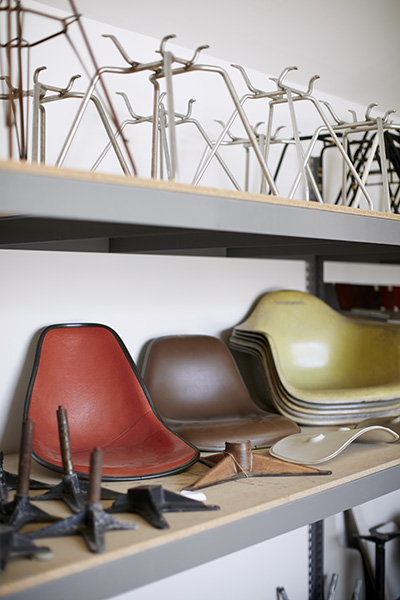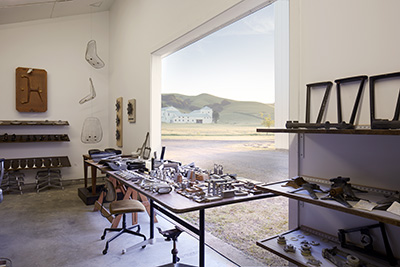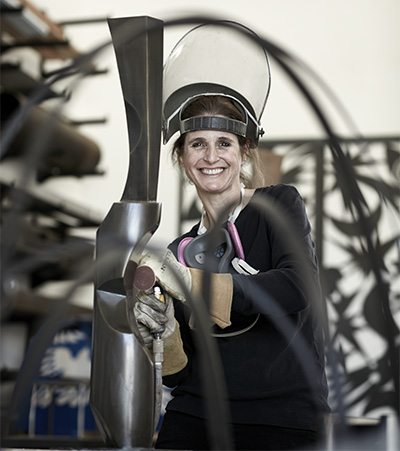
THE CHILDREN of designers and artists often make things, and so, not surprisingly, Llisa Demetrios, 49, is a third-generation maker who seems to follow in the footsteps of her tribe.
At the 27-acre West Marin ranch close to Petaluma where she lives and works, some of her sculptures, particularly totemic works she calls “Lunar Asparagus people,” after a 1935 Max Ernst sculpture, spring from a kind of genetic memory that was formed during frequent trips as a child to Venice, California, to visit one of the greatest modern furniture design duos of the 20th century, Charles and Ray Eames.
Eames was her grandfather, and her late mother, Lucia Eames (his only child with first wife Catherine Woermann), was also a sculptor: her two-dimensional designs were made into large laser-cut steel and bronze objects such as decorative gates. Coincidentally, before studying architecture and design, Eames began his career working in a steel mill. Demetrios began seriously pursuing metal sculpture after earning a history degree.
“I was 12 when Charles passed away and 22 when Ray died, but the lessons I learned from them became indelible,” Demetrios says. “They used to say, ‘Focus on one material and have a deep understanding of that material.’ ” She picked bronze, an alloy she had come to know through her parents. Her father, sculptor Aristides Demetrios, is also the son of a sculptor, George Demetrios, and Aristides’ mother, Virginia Lee Burton, was a textile designer and an illustrator of children’s books.
Small wonder, then, that Llisa Demetrios is attracted to both sculpture and the world of letters. Her husband, Mark Burstein, a computer programmer turned book editor, is an avid collector of many versions of Lewis Carroll’s Alice’s Adventures in Wonderland and Through the Looking Glass, while Demetrios has become the de facto archivist and custodian of the Eameses’ diaries and their zillions of experimental furniture designs and prototypes.
Most of these treasures not already in museum collections now reside in Demetrios’s 8,000-square-foot white painted board-and-batten home and a nearby 11,000-square-foot barn, both designed for her parents by architect William Turnbull, one of the designers of Sea Ranch.
These two Wonderlands, now jointly owned by Demetrios and her four siblings, vaguely resemble hilltop buildings in Italy, and Demetrios’s two school-age children Martin and Sonja and many others are also learning to make things within their walls.
In the wing where her mother lived until her death in 2014, scholars and designers visiting from furniture companies like Herman Miller, which continue to produce the Eameses’ iconic designs, can examine curated selections of archival material in the Eames collection. In the barn, amid hundreds of the Eameses’ prototypes, made of solid wood, metal, plastics, fiberglass and plywood  and continuously being conserved for exhibitions around the globe, Demetrios finds room to make her own signature sculptures.
and continuously being conserved for exhibitions around the globe, Demetrios finds room to make her own signature sculptures.
As an archivist, she has gotten to know most of the Eames objects intimately, but in doing so she has also symbiotically absorbed the Eameses’ iterative process before finalizing a design for production. Like the many versions of chair parts the Eameses created, Demetrios’ abstract “Lunar Asparagus people” and the “Titan” series also start off as multiple maquettes shaped with a band saw from wood dowels, before being translated into larger versions made of thick sheets of bronze that are cut, curved, welded together and then patinated.
Visitors lucky enough to see all this firsthand can also marvel at the Eameses’ flat files and drawers full of handmade papers from Europe and Japan, along with original swaths of fabrics designed by Alexander Girard for Eames chairs and groupings of folk toys and furniture from India, where the Eameses spent a fair amount of time.
“In their projects like the ‘House of Cards’ you might recognize a few of these things,” Demetrios says. But the 1950s cards, which Eames designed to interlock like Lego blocks, also feature humble objects like marbles, penny toys and candle holders, because Eames found they eloquently and instructively exemplified judicious use of simple materials.
Intertwining her work as sculptor and archivist, Demetrios learns from everything she touches or assembles on rolling étagères and shelves in the barn for traveling exhibitions. When toys, furniture and even films by the Eameses get pulled out of storage, “it becomes an opportunity for us to restore and preserve this archival material for future generations,” Demetrios says. But more important, for her and others, any exposition of the Eames legacy can, in his words, “open the door to an idea.”

Zahid Sardar brings an extensive range of design interests and keen knowledge of Bay Area design culture to SPACES magazine. He is a San Francisco editor, curator and author specializing in global architecture, interiors, landscape and industrial design. His work has appeared in numerous design publications as well as the San Francisco Chronicle for which he served as an influential design editor for 22 years. Sardar serves on the San Francisco Decorator Showcase design advisory board.


